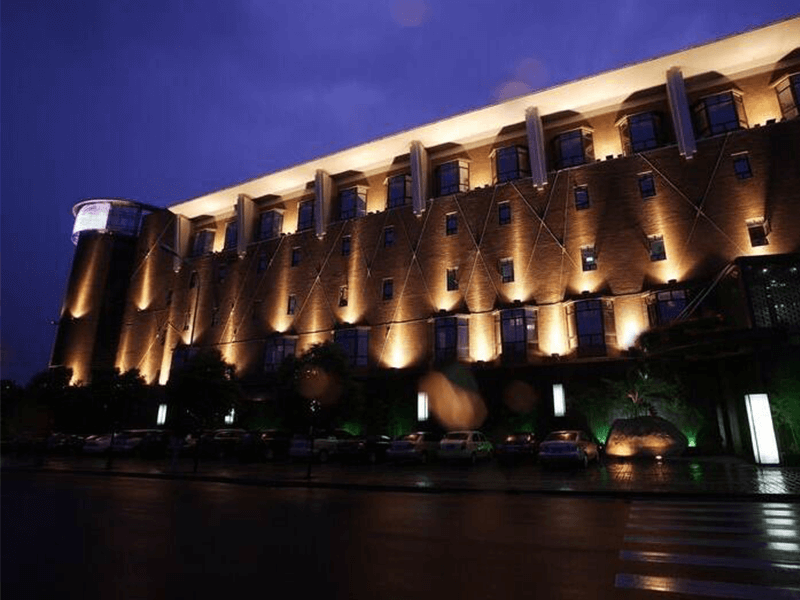Outlined below are the critical advantages of prioritizing high-quality hospitality lighting for your guests:
1. Enhances Atmosphere and Mood
The lighting ambiance within a hotel significantly influences guests’ moods, underscoring the importance of strategic lighting choices. For example, welcoming warm lighting at the hotel entrance sets a hospitable tone. At the same time, LED lights, simulating natural daylight, are favored over conventional yellow hues to create a more inviting atmosphere. Moreover, adjustable lighting fixtures allow personalized control over light intensity, promoting relaxation and facilitating a restful night’s sleep.
2. Enhanced Guest Experience
Crafting a well-illuminated environment in hotels contributes significantly to the overall guest experience. Thoughtfully designed lighting can evoke specific moods, enhance comfort levels, and create memorable moments for guests during their stay.
3. Improved Aesthetics
Strategic lighting design enhances the visual appeal of hotel interiors, accentuating architectural features, decor elements, and spatial layouts. Through meticulous calibration of light and shadow, hotels can fashion captivating environments that imprint enduring memories upon guests.
4. Brand Identity Reinforcement
Hotel lighting is crucial in reinforcing brand identity and conveying a distinct atmosphere or theme. Consistent use of lighting elements aligned with brand values and aesthetics helps hotels differentiate themselves in a competitive market and establish a unique identity that resonates with guests.
5. Energy Efficiency and Cost Savings
Implementing energy-efficient lighting solutions reduces operational costs and aligns with sustainability goals. By leveraging technologies such as LED lighting, hotels can significantly decrease energy consumption, minimize maintenance expenses, and contribute to environmental conservation efforts.
6. Flexible and Adaptive Spaces
Versatile lighting systems enable hotels to adapt to varying needs and occasions, transforming spaces for different functions and events. Whether creating an intimate ambiance for a romantic dinner or providing ample illumination for a conference, flexible lighting solutions enhance the versatility of hotel spaces.
7. Safety and Security
Properly illuminated spaces contribute to guest safety and security within hotel premises. Well-lit pathways, parking areas, and common areas minimize the risk of accidents and deter potential security threats, fostering a sense of comfort and peace of mind among guests.
8. Guest Comfort
Thoughtfully designed lighting that mimics natural daylight promotes guest well-being by regulating circadian rhythms and enhancing mood and productivity. By incorporating circadian lighting principles, hotels can create environments that support the health and comfort of their guests.
9. Stimulates Senses
Effective lighting design in hotel interiors is pivotal in preventing spaces from appearing dull or uninspiring. By ensuring robust and well-coordinated illumination throughout the premises, hotels can make a strong visual impact and leave a lasting impression on guests. Customized lighting designs, particularly in lobbies and other prominent areas, create an aesthetically pleasing environment, setting a positive initial impression and enhancing the overall appeal of the hotel.
10. Enhances Convenience
There needs to be more lighting for guests, mainly when engaged in tasks such as work or searching for items. Adequate illumination facilitates activities like dressing, shopping, or even simple tasks like reading, ensuring guests a seamless and comfortable experience. Failure to provide sufficient lighting can result in dissatisfaction and may prompt guests to seek accommodations elsewhere.
11. Fosters Memorable Experiences
Various factors influence guests’ contentment, with lighting as a crucial element in shaping the overall guest experience. Hotels that prioritize exceptional lighting experiences stand to retain guests and garner positive reviews, ultimately contributing to sustained business success. Hence, hoteliers must dedicate resources towards comprehensive lighting solutions, ensuring the creation of memorable experiences and the cultivation of guest loyalty.
12. Positive Reviews and Repeat Business
A well-lit and inviting ambiance enhances guest satisfaction, leading to positive reviews, recommendations, and repeat business. Consistently providing exceptional lighting experiences builds guest loyalty and fosters long-term relationships with patrons.
